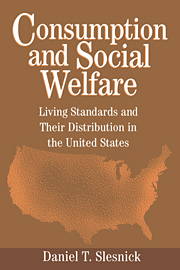Book contents
- Frontmatter
- Contents
- Acknowledgments
- 1 Introduction
- 2 The measurement of economic welfare
- 3 Measuring consumption: An initial look at the data
- 4 The cost of living
- 5 The standard of living
- 6 Does a rising tide raise all ships?
- 7 Consumption and poverty
- 8 Conclusions
- Appendix 1 Measuring individual and social welfare
- Appendix 2 Interpolating and extrapolating the expenditure distribution
- References
- Index
3 - Measuring consumption: An initial look at the data
Published online by Cambridge University Press: 10 December 2009
- Frontmatter
- Contents
- Acknowledgments
- 1 Introduction
- 2 The measurement of economic welfare
- 3 Measuring consumption: An initial look at the data
- 4 The cost of living
- 5 The standard of living
- 6 Does a rising tide raise all ships?
- 7 Consumption and poverty
- 8 Conclusions
- Appendix 1 Measuring individual and social welfare
- Appendix 2 Interpolating and extrapolating the expenditure distribution
- References
- Index
Summary
As is usually the case, obstacles related to the nature, quality, and availability of critical data must be overcome in order to move from the theoretical development to the empirical implementation. This is particularly true of issues related to consumption. In this chapter I propose a definition of consumption that can be used to measure the standard of living, and I examine the extent to which it can be implemented using existing data sources.
WHAT IS CONSUMPTION?
The Haig-Simons definition of consumption is frequently used as a starting point in many empirical studies. Consumption is defined as the difference between income and the change in net worth. Given the variety of ways income can be measured, this does not provide much practical guidance as to how to proceed. As an alternative, I define consumption to be the flow of goods and services to the household that influence well-being over a specific time period. For many items, this is reasonably approximated by the purchases of the household. Overall spending, however, is an inaccurate estimate of total consumption because some goods are consumed without a transaction.
Leisure is probably the most important example of such a commodity. An individual who works eighteen hours per day is not as well off as someone who has the same expenditure but works only eight hours. Excluding leisure from consumption, therefore, could have important consequences for the measurement of the standard of living.
- Type
- Chapter
- Information
- Consumption and Social WelfareLiving Standards and their Distribution in the United States, pp. 42 - 66Publisher: Cambridge University PressPrint publication year: 2000



